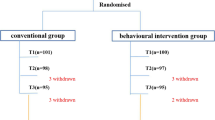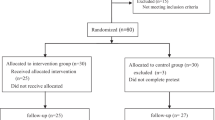Abstract
Neurofeedback is a computer-based behavior training gaining increasing interest in the treatment of children with attention-deficit hyperactivity disorder (ADHD), but is not a complete therapy for these patients. To meet the need for a more integrative approach, this study used neurofeedback with cognitive rehabilitation therapy as a more comprehensive approach for children with ADHD. Thirty children (females) were selected randomly from visitors of 5 clinics in Tehran city. Subjects were placed into 2 experimental groups and 1 control group. Groups were matched based on age, gender and socioeconomic status. One experimental group solely received neurofeedback in 10 sessions, the other experimental group received neurofeedback with cognitive rehabilitation therapy, and the control group left therapy received no therapy or left in the initial stages of therapy. Integrated visual and auditory test (IVA) was used pre-test and post-test to measure attention and impulsivity in children with ADHD, in addition to Neurocognitive Joyful Attentive Training Intervention (NEJATI). Data was analyzed using dependent T-test and analysis of covariance (ANCOVA). There are meaningful differences between all groups in attention and impulsivity factors. The group who received neurofeedback with cognitive rehabilitation therapy showed more improvement in attention and impulsivity factors compared to the group who received only neurofeedback and the control group with no treatment. There was also a significant difference between the solely neurofeedback group and control group in the attention factor. Neurofeedback is a facilitator therapy to improve the attention factor in children with ADHD, but is not a complete therapy due to its lack of support in performance factors. A complementary therapy such as cognitive rehabilitation therapy that focuses more on performance factors would be a more effective therapy as it leads to more positive effects on impulsivity and hyperactivity.
Similar content being viewed by others
References
Adler, L. D., & Nierenberg, A. A. (2010). Review of medication adherence in children and adults with ADHD. Postgraduate Medicine, 122(1), 184–191.
Ahmadlou, M., Rostami, R., & Sadeghi, V. (2012). Which attention-deficit/hyperactivity disorder children will be improved through neurofeedback therapy? A graph theoretical approach to neocortex neuronal network of ADHD. Neuroscience Letters, 516(1), 156–160.
Arns, M., de Ridder, S., Strehl, U., Breteler, M., & Coenen, A. (2009). Efficacy of neurofeedback treatment in ADHD: the effects on inattention, impulsivity and hyperactivity: a meta-analysis. Clinical EEG and Neuroscience, 40(3), 180–189.
Barkley, R. A. (Ed.). (2014). Attention-deficit hyperactivity disorder: A handbook for diagnosis and treatment. New York: Guilford Publications.
Barkley, R. A., Fischer, M., Smallish, L., & Fletcher, K. (2006). Young adult outcome of hyperactive children: adaptive functioning in major life activities. Journal of the American Academy of Child and Adolescent Psychiatry, 45(2), 192–202.
Biederman, J., Monuteaux, M. C., Doyle, A. E., Seidman, L. J., Wilens, T. E., Ferrero, F., & Faraone, S. V. (2004). Impact of executive function deficits and attention-deficit/hyperactivity disorder (ADHD) on academic outcomes in children. Journal of Consulting and Clinical Psychology, 72(5), 757.
Blum, K., Chen, A. L. C., Braverman, E. R., Comings, D. E., Chen, T. J., Arcuri, V., … & Oscar-Berman, M. (2008). Attention-deficit-hyperactivity disorder and reward deficiency syndrome. Neuropsychiatric Disease and Treatment, 4(5), 893.
Charach, A., Ickowicz, A., & Schachar, R. (2004). Stimulant treatment over five years: adherence, effectiveness, and adverse effects. Journal of the American Academy of Child and Adolescent Psychiatry, 43(5), 559–567.
Charach, A., Figueroa, M., Chen, S., Ickowicz, A., & Schachar, R. (2006). Stimulant treatment over 5 years: effects on growth. Journal of the American Academy of Child and Adolescent Psychiatry, 45(4), 415–421.
Chronis, A. M., Fabiano, G. A., Gnagy, E. M., Onyango, A. N., Pelham, W. E., Lopez-Williams, A., … & Seymour, K. E. (2004). An evaluation of the summer treatment program for children with attention-deficit/hyperactivity disorder using a treatment withdrawal design. Behavior Therapy, 35(3), 561–585.
Chronis, A. M., Jones, H. A., & Raggi, V. L. (2006). Evidence-based psychosocial treatments for children and adolescents with attention-deficit/hyperactivity disorder. Clinical Psychology Review, 26(4), 486–502.
Derevensky, J., Sklar, A., Gupta, R., & Messerlian, C. (2010). An empirical study examining the impact of advertisements on adolescent attitudes and behaviors. International Journal of Mental Health and Addiction, 8(1), 21–34.
Fabiano, G. A., Pelham, W. E., Coles, E. K., Gnagy, E. M., Chronis-Tuscano, A., & O’Connor, B. C. (2009). A meta-analysis of behavioral treatments for attention-deficit/hyperactivity disorder. Clinical Psychology Review, 29(2), 129–140.
Faraone, S. V., Biederman, J., Morley, C. P., & Spencer, T. J. (2008). Effect of stimulants on height and weight: a review of the literature. Journal of the American Academy of Child and Adolescent Psychiatry, 47(9), 994–1009.
Farmer, E. M., Compton, S. N., Burns, J. B., & Robertson, E. (2002). Review of the evidence base for treatment of childhood psychopathology: externalizing disorders. Journal of Consulting and Clinical Psychology, 70(6), 1267.
Gevensleben, H., Holl, B., Albrecht, B., Vogel, C., Schlamp, D., Kratz, O., … & Heinrich, H. (2009). Is neurofeedback an efficacious treatment for ADHD? A randomised controlled clinical trial. Journal of Child Psychology and Psychiatry, 50(7), 780–789.
Gevensleben, H., Rothenberger, A., Moll, G. H., & Heinrich, H. (2012). Neurofeedback in children with ADHD: validation and challenges. Psychiatry,, 12(4), 447–460. doi:10.1586/ern.12.22.
Heinrich, H., Gevensleben, H., & Strehl, U. (2007). Annotation: neurofeedback–train your brain to train behaviour. Journal of Child Psychology and Psychiatry, 48(1), 3–16.
Klingberg, T., Fernell, E., Olesen, P. J., Johnson, M., Gustafsson, P., Dahlström, K., … & Westerberg, H. (2005). Computerized training of working memory in children with ADHD-a randomized, controlled trial. Journal of the American Academy of Child & Adolescent Psychiatry, 44(2), 177–186.
Lansbergen, M. M., van Dongen-Boomsma, M., Buitelaar, J. K., & Slaats-Willemse, D. (2011). ADHD and EEG-neurofeedback: a double-blind randomized placebo-controlled feasibility study. Journal of Neural Transmission, 118(2), 275–284.
LeFever, G. B., Villers, M. S., Morrow, A. L., & Vaughn, E. S. (2002). Parental perceptions of adverse educational outcomes among children diagnosed and treated for ADHD: A call for improved school/provider collaboration. Psychology in the Schools, 39(1), 63–71.
Mashhadi, M., Teymouri, S., Soltanifar, A., & Hoseinzademaleki, Z. (2011). Visuo-spatial working memory of ADHD children in Benton Visual Retention Test. Cognitive Science in Education, 21(1), 848–857.
Maurizio, S., Liechti, M. D., Heinrich, H., Jäncke, L., Steinhausen, H. C., Walitza, S., … & Drechsler, R. (2014). Comparing tomographic EEG neurofeedback and EMG biofeedback in children with attention-deficit/hyperactivity disorder. Biological Psychology, 95, 31–44.
Meisel, V., Servera, M., Garcia-Banda, G., Cardo, E., & Moreno, I. (2014). Reprint of “Neurofeedback and standard pharmacological intervention in ADHD: a randomized controlled trial with six-month follow-up”. Biological Psychology, 95, 116–125.
Nejati, V., Bahrami, H., Abravan, M., Sh, R., & Motiei, H. (2013a). Executive function and working memory in attention deficit/hyperactivity disorder and healthy children. Journal of Gorgan University of Medical Sciences, 15(3), 69–76.
Nejati, V., Pouretemad, H. R., & Bahrami, H. (2013b). Attention training in rehabilitation of children with developmental stuttering. Neurorehabilitation, 32(2), 297–303.
Rapport, M. D., Alderson, R. M., Kofler, M. J., Sarver, D. E., Bolden, J., & Sims, V. (2008). Working memory deficits in boys with attention-deficit/hyperactivity disorder (ADHD): the contribution of central executive and subsystem processes. Journal of Abnormal Child Psychology, 36(6), 825–837.
Sergeant, J. A. (2005). Modeling attention-deficit/hyperactivity disorder: a critical appraisal of the cognitive-energetic model. Biological Psychiatry, 57(11), 1248–1255.
Shalev, L., Tsal, Y., & Mevorach, C. (2007). Computerized progressive attentional training (CPAT) program: effective direct intervention for children with ADHD. Child Neuropsychology, 13(4), 382–388.
Sherlin, L. H., Arns, M., Lubar, J., Heinrich, H., Kerson, C., Strehl, U., & Sterman, M. B. (2011). Neurofeedback and basic learning theory: implications for research and practice. Journal of Neurotherapy, 15(4), 292–304.
Sonuga-Barke, E. J., & Castellanos, F. X. (2007). Spontaneous attentional fluctuations in impaired states and pathological conditions: a neurobiological hypothesis. Neuroscience & Biobehavioral Reviews, 31(7), 977–986.
Steiner, N. J., Sheldrick, R. C., Gotthelf, D., & Perrin, E. C. (2011). Computer-based attention training in the schools for children with attention deficit/hyperactivity disorder: a preliminary trial. Clinical Pediatrics, 50(7), 615–622.
Steiner, N. J., Frenette, E. C., Rene, K. M., Brennan, R. T., & Perrin, E. C. (2014). Neurofeedback and cognitive attention training for children with attention-deficit hyperactivity disorder in schools. Journal of Developmental and Behavioral Pediatrics, 35(1), 18–27.
Author information
Authors and Affiliations
Corresponding author
Rights and permissions
About this article
Cite this article
Pahlevanian, A., Alirezaloo, N., Naghel, S. et al. Neurofeedback Associated with Neurocognitive-Rehabilitation Training on Children with Attention-Deficit/Hyperactivity Disorder (ADHD). Int J Ment Health Addiction 15, 100–109 (2017). https://doi.org/10.1007/s11469-015-9621-7
Published:
Issue Date:
DOI: https://doi.org/10.1007/s11469-015-9621-7




